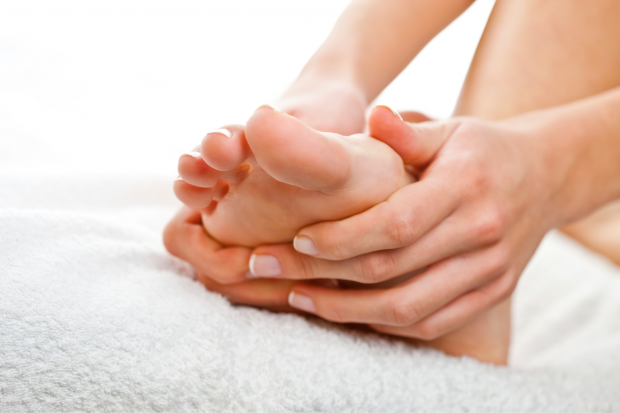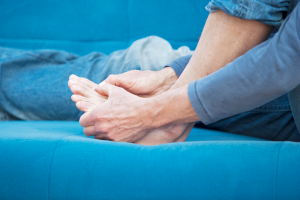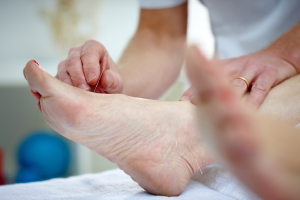Arthritis Powerful Gout Treatments And Prevention
Learn the symptoms, causes, treatment and prevention of gout, a painful type of arthritis that generally attacks the joint of your big toe.
It may be called a rich man’s disease, but gout — a medical condition that involves recurrent attacks of acute inflammatory arthritis — makes you feel anything but well off. In fact, the red, swollen joints that often accompany the foot ailment can cause pain, depression and a sense of hopelessness. Luckily, there are a number of gout treatments and gout prevention tips for the disease that generally attacks the metatarsal-phalangeal joint of the big toe.
Symptoms of Gout
Gout is caused by an elevated level of uric acid in the blood that begins to crystalize and deposit itself as needle-like crystals in the joints, tendons and tissue. The razor-edged uric acid deposits irritate the joints and cause them to become tender, red, swollen and hot. 50% of the time, the only joint that is affected is the joint of the big toe (called podagra gout), but gout pain can also occur in other areas of your feet, as well as in your ankles, knees, hands, wrists, fingers and elbows. Gout can also show itself in the form of kidney stones, decreased kidney function (called urate nephropathy) or as tophi (visible lumps of uric acid crystals under the skin).
Flare ups of gout often happen suddenly and most happen in the middle of the night. The initial flare up is then followed by several hours of intense joint pain and several days or weeks of general joint soreness. In addition to pain, the affected area is usually swollen, tender, warm and red and could be accompanied by fatigue and a high fever. Gout that goes untreated may lead to worsening pain and could cause irreversible joint damage.
Causes of Gout
As we described above, gout is brought on by an elevated level of uric acid in the blood. Uric acid results from the breakdown of purines (which are found in many foods) and it usually dissolves in the blood and is passed through the kidneys and into urine, where it is expelled from the body. However, if the kidneys fail to eliminate enough uric acid or if a person ingests a lot of food and drink with high levels of purine, then uric acid begins to build up in the blood (a condition called hyperuricemia). On its own, hyperuricemia isn’t dangerous and rarely shows symptoms. It’s only when the large amount of uric acid begins to crystalize and the resulting urate crystals deposit themselves into the joints, tendons and surrounding tissue that gout develops. At this stage, gout is called gouty arthritis.
Some things that contribute to elevated levels of uric acid in the blood include:
- Eating foods high in purine levels, which includes steak, seafood and items containing fructose
- Drinking high levels of alcohol, as it affects the body’s ability to expel uric acid
- Obesity, as extra weight affects the body’s ability to expel uric acid
- Certain medications, including aspirin, niacin (a vitamin), Levodopa, Cyclosporine and many diuretics
Gout may also be caused by genetics, recent trauma or surgery and other health problems like psoriasis, hypothyroidism, high blood pressure, diabetes, hemolytic anemia and Lesch-Nyham syndrome/Kelley-Seegmiller syndrome (a rare condition in which the body lacks the enzyme needed to break down uric acid).
In history, gout has been called a rich man’s disease and a king’s disease, because food, drink and weight are all contributing factors that can cause the condition.
Traditional Treatment of Gout
Diagnosis of gout can sometimes be difficult because, as the National Institute of Arthritis and Musculoskeletal and Skin Diseases (NIAMS) states, it often mimics other conditions. Therefore it’s advisable to see a rheumatologist, which is a doctor who specializes in rheumatology (problems involving the joints, soft tissue, vasculitis and autoimmune diseases).
MORE: Toe Stretchers Proven To Help Eliminate Gout Pain
If gout is found to be causing your joint pain and problems, there are many medications that can help treat and reduce flare ups, including steroids, colchicine and nonsteroidal anti-inflammatory drugs (NSAIDs). As you’ll see via sites like WebMD, Medlineplus and MedScape, common medicines to treat gout include Pegloticase, Febuxostat, Allopurinol and Benzbromarone.
With proper treatment, symptoms of gout and future gout flare ups can be mostly eliminated.
Home Remedies and Prevention of Gout
While it’s generally advisable to see a health care provider if you suspect you have gout, there are things you can do at home to prevent the condition and lessen the severity of gout flareups. Common steps include increasing your level of physical activity, drinking lots of water, drinking apple cider vinegar, reducing your intake of alcohol — especially beer and spirits — and making changes to your diet so you are consuming less purine-rich foods (like steak, seafood and items high in fructose). It was once believed that purine-rich vegetables like beans, peas, lentils and spinach could cause gout, but that has since been disproven by nutrition experts.
MORE: Ways to Treat Gout at Home
In addition, it is believed that consuming more dairy products, coffee, cherries and items rich in vitamin C can help decrease your chance of developing gout, perhaps because these items help with insulin resistance and decreasing the level of uric acid in your body. These at-home remedies don't work for everyone, but they're worth trying to help ward off painful gout attacks and prevent more from occurring.
Notice concerning medical entries:
Articles having medical content shall serve exclusively for the purpose of general information. Such articles are not suitable for any (self-) diagnosis and treatment of individual illnesses and medical indications. In particular, they cannot substitute for the examination, advice, or treatment by a licensed physician or pharmacist. No replies to any individual questions shall be effected through the articles.







